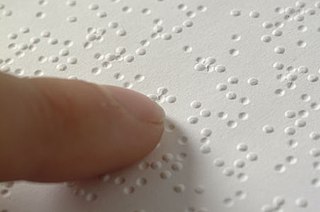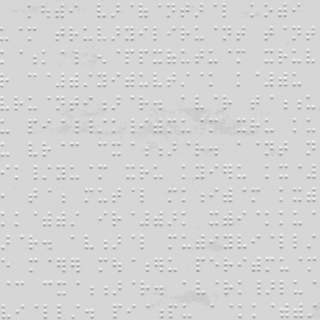Algerian Braille was a braille alphabet used to write the Arabic language in Algeria. It is apparently obsolete. [1]
In Algerian Braille, the braille letters are assigned in numeric order to the Arabic alphabet; standard Arabic Braille on the other hand uses a completely different assignment, following international norms based on the order of the French alphabet. For example, the fifth braille letter, ⠑, is used in Algerian Braille for ج j, the fifth letter of the Algerian/Arabic alphabet. In most braille alphabets today, ⠑ is used for e, the fifth letter of the French/Latin alphabet, or for a letter that sounds like e, no matter where it occurs in those alphabets.
Algerian-type remapping was common in early braille adaptations, but was largely abandoned in favor of mutually understandable standards beginning with the unification of French, English, German, and Arabic Braille on the original order in 1878. [2]

An alphabet is a standardized set of basic written symbols or graphemes that represent the phonemes of certain spoken languages. Not all writing systems represent language in this way; in a syllabary, each character represents a syllable, for instance, and logographic systems use characters to represent words, morphemes, or other semantic units.

The Arabic alphabet, or Arabic abjad, is the Arabic script as it is codified for writing Arabic. It is written from right to left in a cursive style and includes 28 letters. Most letters have contextual letterforms.

Braille is a tactile writing system used by people who are visually impaired, including people who are blind, deafblind or who have low vision. It can be read either on embossed paper or by using refreshable braille displays that connect to computers and smartphone devices. Braille can be written using a slate and stylus, a braille writer, an electronic braille notetaker or with the use of a computer connected to a braille embosser.

Ch is a digraph in the Latin script. It is treated as a letter of its own in Chamorro, Old Spanish, Czech, Slovak, Igbo, Kazakh, Uzbek, Quechua, Guarani, Welsh, Cornish, Breton, Ukrainian Łatynka and Belarusian Łacinka alphabets. In Vietnamese and Modern Spanish, it also used to be considered a letter for collation purposes but this is no longer common.
The Kyrgyz alphabets are the alphabets used to write the Kyrgyz language. The Kyrgyz language uses the following alphabets:

Three alphabets are used to write the Kazakh language: in the Cyrillic, Latin and Arabic scripts. The Cyrillic script is used in Kazakhstan and Mongolia. An October 2017 Presidential Decree in Kazakhstan ordered that the transition from Cyrillic to a Latin script be completed by 2025. The Arabic script is used in parts of China, Iran and Afghanistan.
The Berber Latin alphabet is the version of the Latin alphabet used to write the Berber languages. It was adopted in the 19th century, using varieties of letters.

English Braille, also known as Grade 2 Braille, is the braille alphabet used for English. It consists of around 250 letters (phonograms), numerals, punctuation, formatting marks, contractions, and abbreviations (logograms). Some English Braille letters, such as ⠡ ⟨ch⟩, correspond to more than one letter in print.

Bharati braille, or Bharatiya Braille, is a largely unified braille script for writing the languages of India. When India gained independence, eleven braille scripts were in use, in different parts of the country and for different languages. By 1951, a single national standard had been settled on, Bharati braille, which has since been adopted by Sri Lanka, Nepal, and Bangladesh. There are slight differences in the orthographies for Nepali in India and Nepal, and for Tamil in India and Sri Lanka. There are significant differences in Bengali Braille between India and Bangladesh, with several letters differing. Pakistan has not adopted Bharati braille, so the Urdu Braille of Pakistan is an entirely different alphabet than the Urdu Braille of India, with their commonalities largely due to their common inheritance from English or International Braille. Sinhala Braille largely conforms to other Bharati, but differs significantly toward the end of the alphabet, and is covered in its own article.
Arabic Braille is the braille alphabet for the Arabic language. It descends from a braille alphabet brought to Egypt by an English missionary prior to 1878, so the letter assignments generally correspond to English Braille and to the same romanization as in other braille systems, like Greek and Russian. However, there were once multiple standards, some of which were unrelated to Egyptian Braille. A unified Arabic Braille was adopted in the 1950s as part of the move toward international braille, and it is the standard throughout the Arab world. Other Arabic-based alphabets have braille systems similar to Arabic Braille, such as Urdu and Persian Braille, but differ in some letter and diacritic assignments.
The goal of braille uniformity is to unify the braille alphabets of the world as much as possible, so that literacy in one braille alphabet readily transfers to another. Unification was first achieved by a convention of the International Congress on Work for the Blind in 1878, where it was decided to replace the mutually incompatible national conventions of the time with the French values of the basic Latin alphabet, both for languages that use Latin-based alphabets and, through their Latin equivalents, for languages that use other scripts. However, the unification did not address letters beyond these 26, leaving French and German Braille partially incompatible and as braille spread to new languages with new needs, national conventions again became disparate. A second round of unification was undertaken under the auspices of UNESCO in 1951, setting the foundation for international braille usage today.

French Braille is the original braille alphabet, and the basis of all others. The alphabetic order of French has become the basis of the international braille convention, used by most braille alphabets around the world. However, only the 25 basic letters of the French alphabet plus w have become internationalized; the additional letters are largely restricted to French Braille and the alphabets of some neighboring European countries.

German Braille is one of the older braille alphabets. The French-based order of the letter assignments was largely settled on with the 1878 convention that decided the standard for international braille. However, the assignments for German letters beyond the 26 of the basic Latin alphabet are mostly unrelated to French values.
Luxembourgish Braille is the braille alphabet of the Luxembourgish language. It is very close to French Braille, but uses eight-dot cells, with the extra pair of dots at the bottom of each cell to indicate capitalization and accent marks. It is the only eight-dot alphabet listed in UNESCO (2013). Children start off with the older six-dot script, then switch to eight-dot cells when they start primary school and learn the numbers.
Bengali Braille is used for the Bengali and Assamese languages. According to UNESCO (2013), there are slight different braille conventions for Bengali language in Bangladesh and India, this article compares Bengali Braille in the two countries.
Sinhala Braille is one of the many Bharati braille alphabets. While it largely conforms to the letter values of other Bharati alphabets, it diverges in the values of the letters assigned toward the end of those alphabets.
Irish Braille is the braille alphabet of the Irish language. It is augmented by specifically Irish letters for vowels that take acute accents in print:
IPA Braille is the modern standard Braille encoding of the International Phonetic Alphabet (IPA), as recognized by the International Council on English Braille.

Spanish Braille is the braille alphabet of Spanish and Galician. It is very close to French Braille, with the addition of a letter for ñ, slight modification of the accented letters and some differences in punctuation. Further conventions have been unified by the Latin American Blind Union, but differences with Spain remain.
Navajo Braille is the braille alphabet of the Navajo language. It uses a subset of the letters of Unified English Braille, along with the punctuation and formatting of that standard. There are no contractions.









